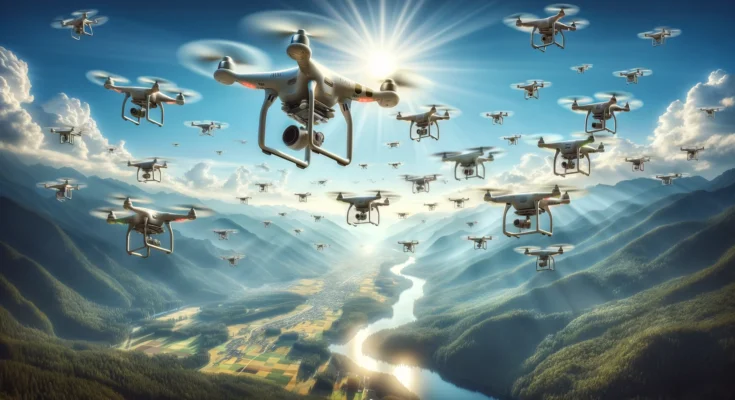Soaring High, But How High? Understanding Drone Regulations and Safety
Ever since their introduction, drones have captured imaginations with their ability to capture stunning aerial footage and offer unique perspectives. But if you’re new to the exciting world of drones, you might be wondering: just how high can drones fly? The answer, like many things related to drones, depends on two main factors: regulations and technical capabilities.
Knowing the Rules of the Sky: Drone Flight Regulations
Safety is paramount when it comes to drone flight. To prevent collisions with manned aircraft and ensure airspace safety, aviation authorities around the world have established regulations for recreational drone use. In the United States, the Federal Aviation Administration (FAA) dictates that drone pilots must keep their unmanned aerial vehicles (UAVs) below a maximum altitude of 400 feet above ground level (AGL). This applies to all hobbyist and recreational drone flights.
How High Can Drones Fly: Understanding Your Drone’s Limits
Even without regulations, a drone’s ability to reach extreme heights is limited by its technical capabilities. Factors like battery life, motor power, and air density all play a crucial role. As a drone climbs higher, the air becomes thinner, reducing the lift it generates. This means the drone’s motors have to work harder to maintain altitude, draining the battery life more quickly.
Maximizing Your Drone’s Potential: Flying Within the Limits
By understanding both regulations and your drone’s capabilities, you can ensure safe and enjoyable flights. Staying within the designated altitude limit (e.g., 400 feet AGL) is not only crucial for safety but also allows you to capture stunning aerial shots while maintaining control of your drone.
In the next section, we’ll explore some of the technologies used to detect drones and how far military drones can fly (keeping in mind this information is generally not applicable to recreational drones).
Keeping an Eye on the Skies: Drone Detection and Military Capabilities

Seeing What Flies: Drone Detection Technologies
With the growing popularity of drones, so too has the need for reliable detection methods. Here’s a look at some of the technologies used to identify and track drones in the airspace:
-
Drone Radar:
Traditional radar systems used for aircraft detection can sometimes pick up on larger drones, especially those operated by law enforcement or military. However, smaller recreational drones might have a weaker radar signature, making them harder to detect.
-
Drone Detection Radar Apps:
There are mobile applications available that claim to detect drone signals. However, the effectiveness of these apps can vary significantly, and some might rely on less reliable methods like detecting Wi-Fi signals from the drone controller.
The Long Arm of the Law: Police Drone Detector Apps
It’s important to manage expectations regarding police drone detector apps. While some law enforcement agencies might have access to specialized drone detection equipment, these are not typically consumer-grade apps available to the public. Currently, there’s no widely available and proven app that can reliably detect all types of drones.
Military Might: How Far Can Military Drones Fly?
Military drones, also known as Unmanned Aerial Vehicles (UAVs), are a different breed altogether. Designed for long-range missions and surveillance, these powerful machines boast impressive flight capabilities. Some high-altitude, long-endurance (HALE) UAVs like the RQ-4 Global Hawk can fly for over 30 hours and reach altitudes exceeding 60,000 feet. However, it’s important to remember that these are highly sophisticated and specialized military equipment, not comparable to commercially available recreational drones.
Understanding the Differences: Recreational vs. Military Drones
Military drones operate under a completely different set of regulations and have a vastly different purpose compared to recreational drones. The information on military drone range serves more as a point of reference, highlighting the technological advancements in unmanned aerial vehicles.
Focus on Safety and Responsibility
While drone detection technologies are evolving, the best way to ensure safe airspace for both manned and unmanned aircraft is to fly responsibly. Familiarize yourself with drone regulations in your area, maintain proper visual contact with your drone during flight, and always prioritize safety over capturing that perfect aerial shot.
This concludes Section 2. In the next section, we’ll delve into some additional tips for maximizing your drone flying experience.
Taking Flight: Essential Tips for Safe and Enjoyable Drone Use
Now that you understand the regulations, limitations, and detection aspects of drone flight, it’s time to explore some practical tips to maximize your piloting experience:
Planning Your Flight:
-
Check the Weather:
Wind speed, visibility, and cloud cover can significantly impact your drone’s control and safety. Always check the weather forecast before heading out for a flight, and avoid operating your drone in windy or rainy conditions.
-
Know Your Location:
Research airspace restrictions in your area. Some locations might have no-fly zones due to airports, military bases, or sensitive areas. Mobile apps and online resources can help you identify these zones.
-
Be Battery Savvy:
Battery life is a crucial factor for drone flight time. Ensure your batteries are fully charged before takeoff and have spare batteries on hand for extended flights.
Mastering the Controls:
-
Practice in a Safe Space:
Before venturing outdoors, familiarize yourself with your drone’s controls in a safe, open area free from obstacles and people. Many drones offer flight simulators that allow you to practice basic maneuvers before taking to the real sky.
-
Start Low and Slow:
Don’t push your limits right away. Begin by flying your drone at a low altitude and close proximity, gradually increasing the distance and height as you gain confidence in your piloting skills.
-
Maintain Visual Contact:
Always keep your drone within your visual line of sight. This allows you to react quickly and safely to any unexpected situations or obstacles.
Safety First:
-
Respect Privacy:
Be mindful of privacy laws and regulations. Avoid flying your drone over private property or near people without their permission.
-
Be Aware of Your Surroundings:
Pay attention to your surroundings while flying your drone. Look out for power lines, trees, buildings, and other obstacles that could pose a collision risk.
-
Fly Sober:
Just like driving, flying a drone requires focus and good judgment. Operating a drone under alcohol or drugs is dangerous.
By following these simple tips and prioritizing safety, you can ensure a fun and rewarding drone flying experience. Remember, responsible drone use benefits everyone, allowing you to explore the world from a new perspective while keeping the airspace safe for all.
The Skies Await: Conclusion and Resources for Drone Enthusiasts
The world of drones offers endless possibilities for exploration, creativity, and pushing the boundaries of what’s possible. From capturing breathtaking aerial photos to assisting with search and rescue operations, drones are revolutionizing the way we see and interact with the world around us.
This article has provided a foundational understanding of drone flight regulations, technical limitations, detection technologies, and essential safety tips. Remember, responsible drone use is paramount. By prioritizing safety, respecting airspace regulations, and being aware of your surroundings, you can ensure a rewarding drone flying experience.
Ready to elevate your drone skills? Let’s level up!
Here are some resources to help you delve deeper into the exciting world of drones:
- Federal Aviation Administration (FAA) Drone Zone:https://www.faa.gov/uas – This official FAA resource provides comprehensive information on drone regulations, safety guidelines, and registration requirements in the United States.
- Dronefly:https://www.dronefly.com/ – A popular website dedicated to all things drone, offering news, tutorials, reviews, and a vibrant community forum for drone enthusiasts.
- The UAV Coach:https://uavcoach.com/ – Packed with valuable resources, including online courses, tutorials, and expert advice on mastering your drone piloting skills and becoming a certified drone pilot.
As drone technology continues to evolve, the possibilities for exploration and innovation are limitless. With responsible use and a passion for flight, you can be a part of this exciting journey into the skies.
Final Thoughts: Soaring Responsibly with Your Drone
The world of drones beckons with endless possibilities. From capturing stunning aerial vistas to assisting in search and rescue missions, these versatile machines are transforming how we interact with the world. This article has equipped you with a solid foundation in drone flight regulations, technical limitations, detection methods, and essential safety practices. Remember, responsible drone use is key. By prioritizing safety, following airspace restrictions, and being mindful of your surroundings, you can unlock a world of exploration and enjoyment with your drone.
Frequently Asked Questions (FAQs):
Q1: Can drones go as high as airplanes?
In most cases, no. Recreational drones are typically limited by regulations and technical capabilities to a much lower altitude than airplanes. Civilian airplanes typically fly at altitudes between 3,000 and 40,000 feet, while recreational drone flight is restricted to a maximum of 400 feet above ground level (AGL) in many countries.
Q2: What is the highest you can legally fly a drone?
The legal altitude limit for drone flight varies depending on your location. In the United States, the Federal Aviation Administration (FAA) restricts recreational drone use to a maximum altitude of 400 feet above ground level (AGL). It’s important to check the regulations in your area before flying your drone.
Q3: How high can a military drone fly?
Military drones, also known as Unmanned Aerial Vehicles (UAVs), are a different breed altogether. Designed for long-range missions and surveillance, these advanced machines boast impressive flight capabilities. Some high-altitude, long-endurance (HALE) UAVs can fly for extended durations and reach altitudes exceeding 60,000 feet. However, it’s crucial to remember that these are highly sophisticated and specialized military equipment, not comparable to commercially available recreational drones.
Q4: Can drones fly 10,000 feet?
Highly unlikely for recreational drones. As mentioned earlier, regulations and technical limitations typically restrict recreational drone flight to much lower altitudes. Military drones, on the other hand, can reach much higher altitudes, with some exceeding 10,000 feet.
By following the tips outlined in this article and prioritizing safety, you can embark on a rewarding journey into the exciting world of drone flight. Remember, responsible drone use benefits everyone, allowing you to explore new perspectives while keeping the skies safe for all.





One Comment on “How High Can Drones Fly? Regulations, Safety & Everything You Need to Know”